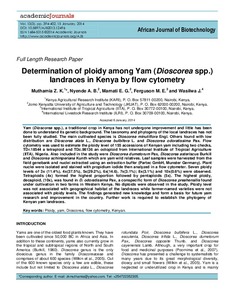| dc.contributor.author | Muthamia, Z.K. |
| dc.contributor.author | Nyende, A.B. |
| dc.contributor.author | Mamati, E.G. |
| dc.contributor.author | Ferguson, M. |
| dc.contributor.author | Wasilwa, J. |
| dc.date.accessioned | 2019-12-04T10:58:24Z |
| dc.date.available | 2019-12-04T10:58:24Z |
| dc.date.issued | 2014 |
| dc.identifier.citation | Muthamia, Z.K., Nyende, A.B., Mamati, E.G., Ferguson, M. & Wasilwa, J. (2014). Determination of ploidy among Yam (Dioscorea spp.) landraces in Kenya by flow cytometry. African Journal of Biotechnology, 13(3), 394-402. |
| dc.identifier.issn | 1684-5315 |
| dc.identifier.uri | https://hdl.handle.net/20.500.12478/981 |
| dc.description.abstract | Yam (Dioscorea spp.), a traditional crop in Kenya has not undergone improvement and little has been
done to understand its genetic background. The taxonomy and phylogeny of the local landraces has not
been fully studied. The main cultivated species is Dioscorea minutiflora Engl. Others found with low
distribution are Dioscorea alata L., Dioscorea bulbifera L. and Dioscorea odoratissima Pax. Flow
cytometry was used to estimate the ploidy level of 155 accessions of Kenyan yam including two checks,
TDr.18544 a tetraploid and TDc.98136 an octoploid from International Institute of Tropical Agriculture
(IITA), Nigeria. Also included in the study were Dioscorea dumetorum Pax, Dioscorea asteriscus Burkill
and Dioscorea schimperiana Kunth which are yam wild relatives. Leaf samples were harvested from the
field genebank and nuclei extracted using an extraction buffer (Partec GmbH, Munster Germany). Plant
nuclei were isolated and stained with propidium iodide then analyzed in a flow cytometer. Seven ploidy
levels of 3x (11.4%), 4x(37.5%), 5x(29.2%), 6x(14.6), 7x(3.1%); 8x(3.1%) and 10x(0.6%) were observed.
Tetraploids (4x) formed the highest proportion followed by pentaploids (5x). The highest ploidy,
decaploid, (10x), was found in D. odoratissima Pax, a conspecific form of Dioscorea preahensilis found
under cultivation in two farms in Western Kenya. No diploids were observed in the study. Ploidy level
was not associated with geographical habitat of the landraces while farmer-named varieties were not
associated with ploidy levels. The findings generated new knowledge and form a basis for future yam
research and improvement in the country. Further work is required to establish the phylogeny of
Kenyan yam landraces |
| dc.format.extent | 394-402 |
| dc.language.iso | en |
| dc.subject | Ploidy |
| dc.subject | Yams |
| dc.subject | Dioscorea |
| dc.subject | Flow Cytometry |
| dc.title | Determination of ploidy among yam (Dioscorea spp.) landraces in Kenya by flow cytometry |
| dc.type | Journal Article |
| dc.description.version | Peer Review |
| cg.contributor.crp | Roots, Tubers and Bananas |
| cg.contributor.affiliation | Kenya Agricultural Research Institute |
| cg.contributor.affiliation | Jomo Kenyatta University of Agriculture and Technology |
| cg.contributor.affiliation | International Institute of Tropical Agriculture |
| cg.contributor.affiliation | International Livestock Research Institute |
| cg.coverage.region | Africa South Of Sahara |
| cg.coverage.country | Kenya |
| cg.authorship.types | CGIAR and advanced research institute |
| cg.iitasubject | Yam |
| cg.journal | African Journal of Biotechnology |
| cg.howpublished | Formally Published |
| cg.accessibilitystatus | Open Access |
| local.dspaceid | 77910 |
| cg.identifier.doi | https://dx.doi.org/10.5897/AJB2013.12496 |

